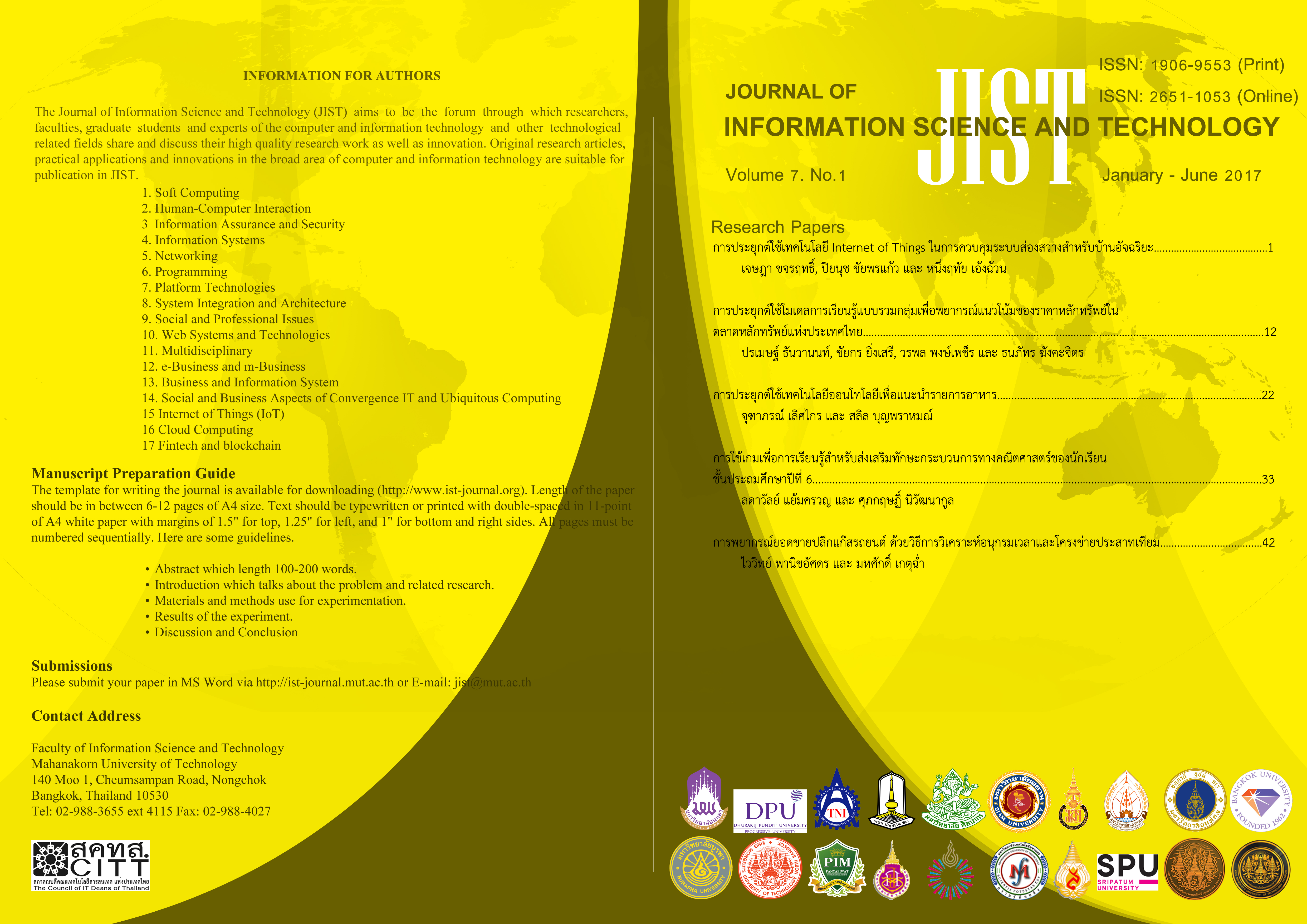The Using of Game-Based Learning for Promote Mathematics Process Skills of 6th Grade Students
Main Article Content
Abstract
- This research aims to use the game-based learning to promote mathematics process skills for 6th grade. The sample is divided into the experimental group or normal learning group, integrated with game-based learning and the control group or normal learning group. The sample size is 30 students for each group. The experimental data are collected from the mathematical process skills test. There are five differences in mathematics process skills: 1) problem solving, 2) reasoning, 3) communication and presentation, 4) linking, and 5) creative. The experimental results indicate that the experimental group has a significantly higher mathematical skills than the control group at the 0.05 level for all skills, and the experimental group has a significantly higher post-test mathematical skills than pre-test at the 0.05 level for all skills.
Article Details
This work is licensed under a Creative Commons Attribution-NonCommercial-NoDerivatives 4.0 International License.
I/we certify that I/we have participated sufficiently in the intellectual content, conception and design of this work or the analysis and interpretation of the data (when applicable), as well as the writing of the manuscript, to take public responsibility for it and have agreed to have my/our name listed as a contributor. I/we believe the manuscript represents valid work. Neither this manuscript nor one with substantially similar content under my/our authorship has been published or is being considered for publication elsewhere, except as described in the covering letter. I/we certify that all the data collected during the study is presented in this manuscript and no data from the study has been or will be published separately. I/we attest that, if requested by the editors, I/we will provide the data/information or will cooperate fully in obtaining and providing the data/information on which the manuscript is based, for examination by the editors or their assignees. Financial interests, direct or indirect, that exist or may be perceived to exist for individual contributors in connection with the content of this paper have been disclosed in the cover letter. Sources of outside support of the project are named in the cover letter.
I/We hereby transfer(s), assign(s), or otherwise convey(s) all copyright ownership, including any and all rights incidental thereto, exclusively to the Journal, in the event that such work is published by the Journal. The Journal shall own the work, including 1) copyright; 2) the right to grant permission to republish the article in whole or in part, with or without fee; 3) the right to produce preprints or reprints and translate into languages other than English for sale or free distribution; and 4) the right to republish the work in a collection of articles in any other mechanical or electronic format.
We give the rights to the corresponding author to make necessary changes as per the request of the journal, do the rest of the correspondence on our behalf and he/she will act as the guarantor for the manuscript on our behalf.
All persons who have made substantial contributions to the work reported in the manuscript, but who are not contributors, are named in the Acknowledgment and have given me/us their written permission to be named. If I/we do not include an Acknowledgment that means I/we have not received substantial contributions from non-contributors and no contributor has been omitted.
References
2. สถาบันส่งเสริมการสอนวิทยาศาสตร์และเทคโนโลยี. การวัดและประเมินผลคณิตศาสตร์. กรุงเทพฯ: ซีเอ็ดยูเคชั่น จํากัด; 2555.
3.สถาบันทดสอบทางการศึกษาแห่งชาติ [อินเทอร์เน็ต]. ผลการทดสอบการศึกษาระดับชาติขั้นพื้นฐาน (O-NET) 2559; 2560. สืบค้นเมื่อ 3 มกราคม 2560. เข้าถึงได้จาก http://www.newonetresult.niets.or.th/AnnouncementWeb/PDF/SummaryONETM6_2559.pdf
4. สถาบันส่งเสริมการสอนวิทยาศาสตร์และเทคโนโลยี [อินเทอร์เน็ต]. สรุปผลการวิจัยโครงการ TIMSS 2015; 2558. สืบค้นเมื่อ 3 มกราคม 2560. เข้าถึงได้จาก: https://drive.google.com/file/d/0Bza8voFmdF srRGlYbmdPa0pkXzg/view.
5. เอื้อมพร หลินเจริญ, สิริศักดิ์ อาจวิชัย และภีรภา จันทร์อินทร์. ปัจจัยเชิงสาเหตุที่ส่งผลต่อผลสัมฤทธิ์การสอบ O-NET ของนักเรียนระดับชั้นประถมศึกษาปีที่ 6 และนักเรียนระดับชั้นมัธยมศึกษาปีที่ 6 ต่ำ. รายงานการวิจัย สถาบันทดสอบทางการศึกษาแห่งชาติ (องค์การมหาชน); 2552.
6. ชัยศักดิ์ ลีลาจรัสกุล. เอกสารคำสอนรายวิชาหลักสูตรและการสอนคณิตศาสตร์โรงเรียนมัธยมศึกษา. กรุงเทพฯ: คณะศึกษาศาสตร์ มหาวิทยาลัยศรีนครินทรวิโรฒ; 2543.
7. จิราภรณ์ ศิริทวี. กลยุทธ์การพัฒนาผู้เรียน: ประสบการณ์จากการปฏิบัติจริง. กรุงเทพฯ: ศูนย์ส่งเสริมและพัฒนาพลังแผ่นดินเชิงคุณธรรม (ศูนย์คุณธรรม) สำนักงานบริหารและพัฒนาองค์ความรู้ (องค์การมหาชน); 2551.
8. กระทรวงศึกษาธิการ. หลักสูตรแกนกลางการศึกษาขั้นพื้นฐาน พุทธศักราช 2551. กรุงเทพฯ: โรงพิมพ์ชุมนุมสหกรณ์การเกษตรแห่งประเทศไทย; 2551.
9. บุญญา เพียรสวรรค์. การพัฒนาชุดกิจกรรมเพื่อส่งเสริมการให้เหตุผล เรื่อง การให้เหตุผลเกี่ยวกับรูปสามเหลี่ยมและรูปที่เหลี่ยม สำหรับนักเรียนชั้นมัธยมศึกษาปีที่ 3. วารสารมหาวิทยาลัยนเรศวร 2560;3(25) :156-168.
10. นภาพันธ์ ศรีชัย, มารศรี กลางประพันธ์ และสมเกียรติ พละจิตต์. การพัฒนาทักษะกระบวนการทางคณิตศาสตร์ ผลสัมฤทธิ์ทางการเรียนและความพึงพอใจต่อการเรียนโดยวิธีสอนแบบโครงงานร่วมกับการจัดการเรียนรู้แบบ 4 MAT ของนักเรียนชั้นประถมศึกษาปีที่ 4. วารสารบัณฑิตศึกษา 2558;2(58):67-78.
11. Katmada A, Mavridis A, Tsiatsos T. Implementing a Game for Supporting Learning in Mathematics. The Electronic Journal of e-Learning 2014;12(3):230-242.
12. กิรณา อึ้งสกุล, โสพล มีเจริญ, สุรพล บุญลือ. การสร้างวิธีการสอนร่วมกับแอพพลิเคชั่นแบบพกพา (Tablet) เพื่อพัฒนาทักษะการแก้โจทย์ปัญหาคณิตศาสตร์. ใน: เอกสารการประชุมสัมมนาทางวิชาการ มทร.ตะวันออก มรภ.กลุ่มศรีอยุธยา และราชนครินทร์วิชาการและวิจัย; 2557.
13. สุรางค์ โค้วตระกูล. จิตวิทยาการศึกษา. พิมพ์ครั้งที่ 11. กรุงเทพฯ: สำนักพิมพ์แห่งจุฬาลงกรณ์มหาวิทยาลัย; 2556.
14. International Standard Organization. ISO/IEC 9126: Information Technology – Software Product Evaluation - Quality Characteristics and Guidelines for Their Use. Geneva: International Organization for Standardization; 1991.
15. Likert R. A Technique for the Measurement of Attitudes. Archives of Psychology 1932;140:1-55.
16. Fisher RA. Statistical methods for research workers. 11th Edition. Edinburgh: Oliver & Boyd; 1950.
17. Rovinelli RJ., Hambleton RK. On the Use of Content Specialists in the Assessment of Criterion-Referenced Test Item Validity. Dutch Journal for Educational Research 1997;2(2):49-60.
18. Kuder GF, Richardson MW. The theory of estimation of test reliability. Psychometrika 1937;2:151-160.
19. Krejcie R.V., Morgan D.W. Determining Sample Size for Research Activities. Educational and Psychological Measurement 1970;30: 607-610.
20. Student. The Probable Error of a Mean. Biometrika 1908;6(1):1- 25.
21. Heimer RT, Trueblood CR. Strategies for Teaching Children Mathematics. Washington D.C.: Addison – Wesley Publishing Company; 1977.
22. Grambs JD, Carr JC, Fitch RM. Modern Methods in Secondary Education. 3rd Edition. U.S.A.: Holt, Rinehart and Winston, Inc; 1970.


